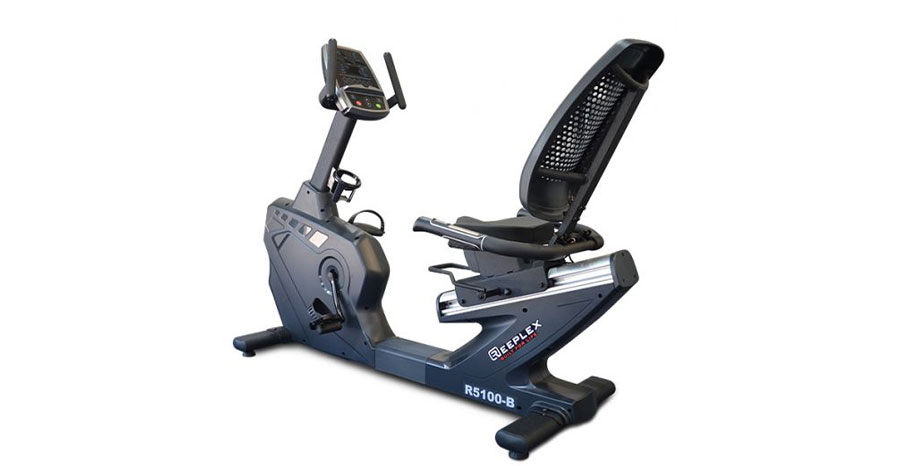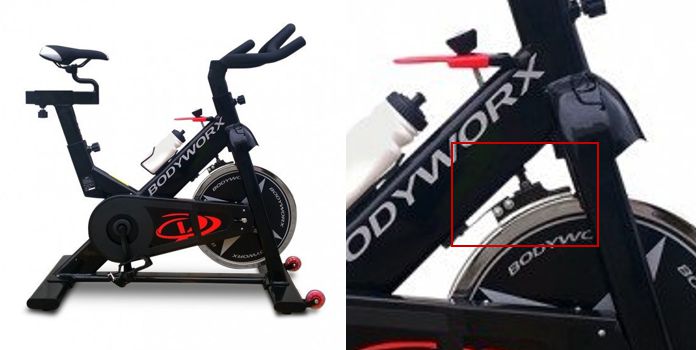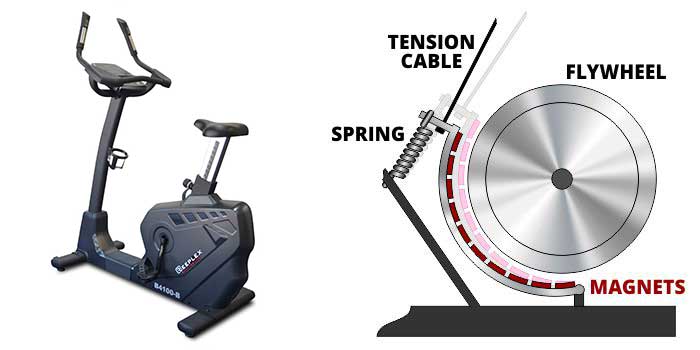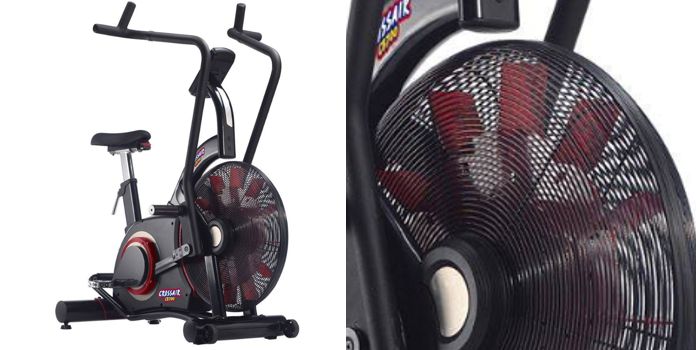
The Ultimate Exercise Bike Buying Guide: Part 2 – The Flywheel
This week we continue our 3 part series on finding the right exercise bike for your at-home needs. Last week we examined the 3 different types of exercise bikes: spin, upright and recumbent. This week we continue by taking an in-depth look at flywheels.
Benefits of Having an Exercise Bike
Having an exercise bike at home comes with a multitude of benefits that cater to both physical and mental well-being. Here are some of the key advantages:
1. Weight Loss and Fat Burning
Using an exercise bike is an efficient way to burn calories and aid in weight loss. A 30-minute session can burn between 200 to 300 calories, depending on the intensity and the individual’s weight. Consistent use, combined with a healthy diet, can significantly contribute to fat loss and overall fitness improvements.
2. Cardiovascular Health
Regular cycling helps improve cardiovascular health by making the heart more efficient at pumping blood. It can also help regulate blood pressure, lower bad cholesterol, and increase good cholesterol levels. These benefits collectively reduce the risk of heart attacks and other cardiovascular issues.
3. Low-Impact Exercise
Cycling on an exercise bike is a low-impact activity, making it easier on the joints compared to high-impact exercises like running. This makes it an excellent option for people with joint issues or those recovering from injuries. It’s also beneficial for older adults who need to maintain an active lifestyle without putting too much strain on their bodies.
4. Improved Mental Health
Exercise bikes can boost mental health by releasing endorphins, which help improve mood and reduce stress, anxiety, and depression. The repetitive motion of cycling can also be meditative, helping to clear the mind and enhance concentration.
5. Enhanced Sleep Quality
Regular use of an exercise bike can lead to better sleep patterns. Physical activity helps regulate circadian rhythms, making it easier to fall asleep and stay asleep. Additionally, the reduction in stress levels from regular exercise can also contribute to better sleep quality.
6. Versatility and Convenience
Exercise bikes are highly versatile and can accommodate various fitness levels through adjustable resistance settings. They can be used for different workout intensities, from low-intensity steady-state rides to high-intensity interval training (HIIT). Having an exercise bike at home also means you can work out regardless of the weather or time constraints, making it a convenient option for maintaining a regular exercise routine.
7. Energy Boost
Cycling has been shown to improve energy levels significantly. Regular cycling stimulates the release of dopamine, which boosts energy and decreases fatigue. This can help individuals feel more energized throughout the day.
The most important functional part of any exercise bike is the flywheel. How heavy is it, and what braking system does it use? Exercise bike flywheels are such an extensive and important subject that they deserve a post all to themselves.
Looking for fitness equipment for your home or commercial gym? Dynamo Fitness offers a wide range of gym equipment online or in-store.
Read Also: Ski Machine Workouts
The Flywheel Itself
The flywheel is a heavy metal disk, usually found at the front of the bike. Except for many models of spin bikes these wheels are almost always enclosed in a plastic housing for safety and noise reduction. The flywheel is connected to the pedals by a belt or chain. It stores momentum in lieu of the inertia you would have from forward movement on a road bike. Because the flywheel is heavy (some reach over 20 kilos) it provides resistance when you first start to pedal. This resistance is very similar to what you would experience when starting out on a road or mountain bike.
The weight of the flywheel is often an indicator of the quality of the stationary bike. The heavier the wheel, the more sturdy the bike will need to be to stabilize it. In addition, heavier wheels store more energy and are harder to get moving so can better imitate the resistance of riding a wheeled bike.
Three Resistance Types
Resistance on an exercise bike mimics physics in the real world. When you’re riding a wheeled bike, resistance comes from air, friction, and gravity. All of these forces work to impede your progress and they are the reason why riding a bike at any speed above a walk is physically strenuous.
Exercise bikes are of course stationary. Air and gravity are not a factor, so friction must replace these forces. Exercise bikes use three different types of resistance to set the difficulty of your workout.
Direct Contact
A band around the outside of the wheel, or a brake pad which presses against the sides or outer rim, provide direct contact resistance. The pressure of the band or brake pad can be adjusted. The greater the pressure, the higher the resistance. The effect is almost identical to the brakes found on wheeled bikes, but the intent is not to stop the wheel but to make it harder to keep it moving.
Note the pressure pad or brake on the outer rim. Our BodyWorx A117BB Black Spin Bike is an example of a direct contact exercise bike. Friction increases as the pressure on the brake is turned up via the knob visible above it.
Pros
Extremely high resistance levels
If you’re a cycling monster or have muscled thighs like tree trunks, this type of resistance may be preferable for you, as it can be set at very challenging levels.
Cons
Friction comes at a cost
This type of mechanical resistance puts a lot of strain on the equipment. Bands or pads may need to be replaced frequently, and the bike itself will experience greater stresses than other types of resistance systems. In short, your bike may wear out faster.
Noise
Mechanical resistance also creates more noise than other types. If you work out alone with headphones on it might not matter, but if you prefer to read while cycling or other people will be within earshot, this may not be the right option for you.
Magnetic
It used to be that direct contact resistance was the preferred method. However, magnetic resistance technology has progressed to the point where many people prefer it, and higher end bikes are almost always of this type.
Magnets on either side of the flywheel create resistance through magnetic attraction. The magnets don’t touch the wheel and resistance can be adjusted by their distance from it. The closer they are to touching the wheel, the higher the resistance. Try pushing two opposing magnets together and you’ll get an excellent sense of how this works.
By removing the friction, magnetic resistance systems seek to overcome the wear and tear issues which affect direct contact.
This magnetic flywheel is slowed by the power of the magnets on the spring-loaded frame. The push/pull between the tension cable and the spring control the distance from the magnets to the flywheel. The closer the magnets are, the greater the resistance.
Pros
Quiet and Smooth
Because nothing is touching the wheel other than the drive band or chain, there’s nothing to make noise. If you want quiet while you exercise, this is the right system for you. The lack of friction also makes for a smoother ride.
Marked Levels
While some higher end direct contact models do have marked resistance settings, these will change over time as the belt or pads wear out. They are definitely less accurate than magnetic resistance marked settings. Lower end direct contact models may not have marked settings at all. You’ll simply need to manually adjust until it feels right.
With magnetic resistance systems, you set the resistance electronically on the console. This makes it easy to get exactly the same resistance at the start of every workout, or adjust it up or down in predictable increments as desired.
Durability
Less friction means less torque on the superstructure of the stationary bike and less wear and tear on the moving parts. This means that direct contact resistance bikes have a high maintenance cost compared to the other two types.
The only parts on a magnetic resistance bike that come in contact with each other are the chain or band, the pedal gear, and the flywheel axle. All of these parts are typically manufactured for smooth movement using high-quality bearings. What all this means is that with very little friction, wear is greatly reduced. These types of bikes can be maintenance free throughout their lifespan.
Greater Resistance Range
With direct contact systems, achieving very low levels of resistance can be a challenge. Any friction at all tends to make it hard to pedal. That’s one of the reasons these bikes are for hard-core cyclists and fitness enthusiasts.
Magnetic resistance systems are highly adjustable. They can be set so low as to provide almost no resistance at all – good if you’re just starting out on your exercise lifestyle and don’t want to end up unable to walk the next day. By the same token, high-end magnetic systems are capable of the same challenging levels of resistance as direct contact, but without the extreme wear that comes from that degree of friction.
Cons
Expense. Due to their electronic systems and meticulous engineering, these bikes will set you back a fair bit more than most direct contact exercise bikes.
Fan-based
Less common than the other two types, there are still some fan-based models. You may have seen this type of system on rowing machines, where they are more typical. The fan provides little resistance at low speeds, but air resistance builds as you pedal faster. In addition, some of these models may be equipped with an adjustment knob or lever which can change the angle of the fan blades, thus changing the resistance.
Air bikes are slowed by a fan rather than a flywheel. The faster you pedal, the greater the air resistance and the harder you’ll need to work.
Pros
Noise
Not as quiet as some higher end magnetic models, but still considerably less noisy than most direct contact bikes.
A Cool Breeze
The fan housing is generally constructed to direct at least some of the air flow toward you as you pedal. It’s like free air conditioning!
Low Maintenance
Fan based resistance has about the same number of parts in contact as do magnetic systems, which is to say very few. Fans are also lighter than flywheels, so the construction of the bike can be lighter while still being sturdy. You may have to occasionally tighten some screws, but otherwise, these stationary bikes are largely maintenance free.
Cons
Expense
Comparable to some magnetic resistance bikes, these will cost more than direct contact.
How Do I Decide?
The best way is to try them out. Most gym equipment stores will allow you to try their demo models. You can also visit your local gym where they’ll allow you to do a single workout for a small one-time fee. Most gyms will have both direct contact and magnetic resistance exercise bikes. You may find a fan-based bike as well but these are becoming increasingly rare in gyms.
Shop Fitness Equipment Today
Upgrade your home gym with top-tier exercise equipment from Dynamo Fitness Equipment. Visit our Exercise Equipment Adelaide Store to explore a wide range of squat racks, stair climbers, shoulder exercise machines, and aerobic steps. Don’t miss out on our extensive collection at the fitness equipment Sydney showroom, featuring everything from state-of-the-art machines to essential accessories like floor trim. Achieve your fitness goals with the best in the industry. Shop today and elevate your workout experience!
You can view our large range of exercise bikes here
Will Dove
Latest posts by Will Dove (see all)
- Body Weight Training 2.0: Calisthenics - 22 Apr
- All About Protein Powders - 9 Apr
- Top 5 Fitness Trends for 2019 That You Should Try - 30 Mar







